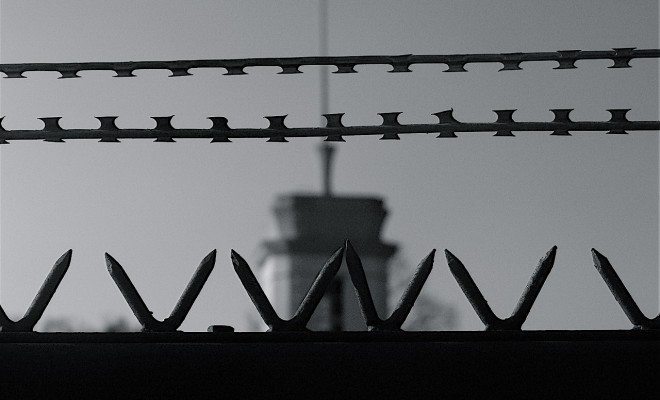 Image Courtesy of [Matthias Müller via Flickr]
Image Courtesy of [Matthias Müller via Flickr]
Crime
Private Prisons Much More Likely to Hold Minorities
A recent study concluded that private prisons are more likely to hold African American prisoners when compared to public correction facilities. The study argues that contractual provisions, specifically health care related exemptions, have a measurable effect on the racial makeup of private correctional populations and are the primary contributors to this trend.
This report was the second part of a research study conducted by Christopher Petrella, a UC-Berkeley graduate student, and sought to explain the existence of the disparities found in his initial research. Petrella argues that the existence of unique medical exemptions in private prison contracts has caused their populations to include more black Americans than public prison populations.
We have covered private prisons before, but this study marks another example of why private prisons have become controversial recently. Private for-profit prison companies hold over 12 percent of the total prison population. The total number of inmates in these facilities totals over 130,000, and has continued to rise in recent years. These prisons have grown dramatically in size over the years and continue to develop political influence.
According to Petrella’s research, the presence of health exemptions for private prisons, allow such companies to avoid holding prisoners with chronic medical conditions or who may have above average medical costs. Statistics further indicate that younger inmates are much more likely to be black, and older inmates are relatively more likely to be white. The study attributes this disparity to the recent “war on drugs” campaign, which has had a disproportionate effect on young black Americans.
According to the Bureau of Justice Statistics’ Prisoners in 2010 report, the estimated sentenced prisoner rate per 100,000 people was significantly larger for blacks in every age group, particularly those under the age of 50. Consequently, age becomes what Petrella calls “a proxy” for race, as grouping inmates by age also tends to separate them by skin color. Petrella cites a study done by the ACLU to explain how age affects health care costs. The ACLU found that the annual cost of holding the average prisoner is $34,135, but the cost of holding a prisoner over the age of 50 years old is $68,270.
It is also important to note that Petrella decided not to use statistics from federal detention centers that are operated by Immigration and Customs Enforcement or local ones controlled by the U.S. Marshall’s Service in order to avoid inflating the statistics even further.
Steve Owens, the senior director of public affairs for Corrections Corporation of America, told NPR that he found the study to be “deeply flawed.” He cited the fact that the government agrees to the contracts and typically has a lot of control over what prisoners are held in private facilities.
Although, it does not appear that race was the motive for these exemptions and policies, it does point to another example of discrimination and racial injustice within the prison system. Profit is clearly the overriding rationale behind the actions of private prison companies, but this problem is simply a part of a much larger issue of racial injustice.
Racial Injustice in Prisons
Here is an infographic created by ArrestRecords.com, which outlines many prominent examples of racism in the criminal justice system. According to the infographic, African Americans represent 37.1 percent of the American prison population, yet makeup only 12.6 percent of the country’s citizens. Racism is arguably even more noticeable among prisoners on death row, as blacks represent 43 percent of that population. Furthermore, African Americans who have killed white people were sentenced to death 22 times more often than a white person convicted of killing a black person.
Statistics also show a growing trend in the proportion of blacks in the overall prison population. This holds true for men, women, adults and children, as prisoner totals have gone up dramatically since 1960. Not only are blacks more likely to be incarcerated during their lifetime, they are also more likely to receive higher bail totals, longer prison sentences, get stopped by law enforcement officers in public, and get convicted by all-white juries.
The infographic also indicates how the “War on Drugs” has adversely affected the black community in America. Although blacks represent just over 12 percent of the population, they constitute 38 percent of those arrested for drug offenses, and as many as 58 percent of the people in state prisons for such crimes. According to The Sentencing Project the average drug related sentence for African Americans is almost the same as the average violent crime sentence for a whites. This indicates that not only are black people more likely to be convicted of a crime, but are also more likely to serve more jail time than a white person would be for the same crime.
Finally, some statistics indicate that there is hope for the future, as the incarceration rate for both black male and females has started to decrease in recent years. These rates remain well above those of white males and females, but these trends may indicate that the gap is starting to close. However, there is a long way to go before the American prison system is equitable, and much needs to be done to combat the extensive history of injustice within the United States. Creating awareness and making reforms in the criminal justice system are an important part of addressing many of the existing issues.
[NPR] [The Color of Corporate Corrections]








Comments